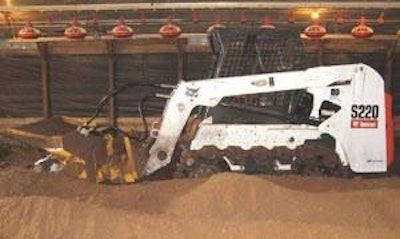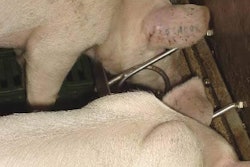
Managing litter quality is an important aspect of raising healthy broilers economically. Litter quality both directly and indirectly impacts bird respiratory health, microbe numbers and viability, ventilation needs, power usage and worker health. For these reasons, managing broiler litter should be an organised effort by both broiler company personnel and the grower.
Benefits of re-using litter
In the USA, broiler litter re-use for a period of time is the norm. Experience has shown that this system works well and has some practical advantages over cleaning out after each flock. In addition, environmental regulations restrict how farmers can use broiler litter as a fertiliser, forcing broiler growers to use and market their litter more carefully. Scarcity of suitable litter materials is an increasing problem in many broiler-growing regions. Short pine shavings supplies and a lack of alternatives are making it expensive and/or difficult for growers to source suitable materials for replacement after clean-out and top dressing.
In a given region, one or more of these situations may make frequent clean-outs unattractive. Litter can be re-used successfully if managed properly.
Used litter naturally exposes young birds to low numbers of many different types of micro-organisms. Early exposure provides a form of competitive exclusion inoculation for birds, such that they are less open (naive) to infection by pathogens. This assumes, of course, that no significant disease problems carried over from the previous flock. Young broilers can be exposed to low levels of a variety of bacteria, coccidia and vaccine strains of viruses. Many operations that clean out litter after every flock experience more severe forms of common diseases because birds reach later ages in a naive state before being exposed to the pathogens. This means that they have lower immunity and less gut colonisation by competing bacteria.
Performance boost on new litter
In Alabama, the majority of growers clean out litter from their houses once a year in the spring. This system provides a yearly boost in performance when microbe numbers are reduced and sub-clinical infection is at a minimum. Growers report an improvement in settlement ranking associated with new litter, and integrators expect improvements of 3-4 points in feed conversion and 1.5 points in condemnations in the processing plant.
In deciding when to clean out litter, the short-term benefits in live performance seen with clean-out must be weighed against the costs and labour involved in frequent clean-out, the ability of the grower to obtain sufficient bedding materials at a reasonable price and the local market for litter as a fertiliser source. Currently, a truckload of pine shavings costs around US$700. This would place the cost of replacing shavings in a house at US$700-1400. The cost of having the litter removed would be a further addition to the cost of cleaning out regularly. This must be balanced against the increased costs of ventilation and litter treatment necessary with built-up litter.
Managing litter between clean-outs
If conditions are such that regular clean-outs are difficult to accomplish for any reason, growers must use litter management techniques to keep built-up litter from being an economic drain on their operation. During the grow-out period, ventilation, heating and water quality must be managed to keep litter dry and minimise ammonia and microbe levels.
If house management is sub-standard during grow-out, microbe levels, particularly bacteria and coccidia viruses prefer dry conditions will increase to the point that reducing these levels between flocks becomes more difficult. For this reason, built-up litter systems require tighter house management to work properly. This concept becomes particularly evident where growers must re-use litter over a prolonged period for as long as one year. Good house management, combined with a number of techniques, e.g. de-caking, windrow composting, litter treatments and tilling, will allow growers to make the most of built-up litter.
Downtime must also be considered if litter is re-used. Resting litter between flocks allows microbe levels to decrease as the litter cools and dries out. An economic balance must be reached between company and grower income and the biology of house environment. A minimum of 10 days downtime will allow litter to cool and dry sufficiently to reduce microbe numbers. Disease threat will be further reduced if 14 days downtime can be achieved. It must be remembered, however, that spore-forming bacteria will not be reduced with downtime. For this reason, spore-formers like clostridia (associated with gangrenous dermatitis and necrotic enteritis) may build up over time. Clean-out is the best option if conditions associated with spore-forming bacteria become a problem.
In-house composting
During the last few years, broiler producers have refined methods of in-house litter composting with the intent of using this technique to reduce bacterial and viral load between grow-outs.
Growers frequently use a box blade to create windrows, although several companies make compost-turning equipment that works well to make windrows in the poultry house. Creating windrows requires several hours of work per house. Re-spreading litter after composting will take a similar amount of time. Cake may be left in to provide enough moisture for compost bacteria to proliferate. If litter moisture is low, the desirable bacteria will not grow and the proper composting temperature will not be obtained. Most growers will run a cruster through the house to break up the litter and incorporate air.
Research completed in the Poultry Science Department at Auburn University and at Louisiana State University (Theresia Lavergne, associate professor-poultry) shows that maximum temperatures (54-60°C) are reached within 24 hours of windrowing, and temperatures begin to drop after about 48 hours. This is long enough to kill most pathogenic bacteria and viruses.
Based on this, a 3- to 5-day in-house composting programme between flocks is a useful way to reduce viral and bacterial pathogens and improve bird performance. High temperatures were maintained longer in covered windrows. Covering allows all litter (including that on the outside) to compost and holds ammonia that contributes to killing micro-organisms.
If clean-out is not feasible, windrow composting to partially rejuvenate litter makes sense from an economic viewpoint. Reduced levels of fragile micro-organisms such as the laryngotracheitis virus, campylobacter and salmonella help to ensure optimum bird performance and reduce human food safety concerns. Reduced loads of other harmful bacteria and viruses allow birds to use feed for growth and performance rather than for fighting off mild (and often unseen) disease challenges. Also, litter ammonia levels are reduced at the start of the next batch of birds. Although improvements in performance from in-house litter composting may not match total clean-out and sanitation, health and performance improvements are substantial and pay dividends for the efforts that the grower must invest.
Litter treatments
Much of the broiler industry has embraced the use of litter treatments to improve performance and health when broiler litter is re-used. In general, reduction of house ammonia levels is the primary purpose for using a litter treatment, although reducing litter pH also reduces microbe viability. In recent years, reasons for using a litter treatment and any potential benefits from its use have expanded to include improvements in performance and environmental concerns. Litter treatments to reduce ammonia offer a better in-house environment for the birds. This is important if conditions dictate the re-use of litter for extended periods.
Built-up litter systems are common throughout the broiler industry and can be used effectively with good management. Despite this, a yearly clean-out does generally show a transitory boost in performance, indicating that sub-clinical infections and/or ammonia emissions do reduce performance measurably.
Many factors influence how often a grower can clean out broiler house litter, including litter sale/disposal options, bedding availability and cost, perceived disease load and litter quality. Techniques such as in-house litter composting, frequent between-flock tilling and litter treatments may help growers manage built-up litter if frequent clean-out is impractical.















